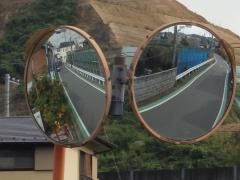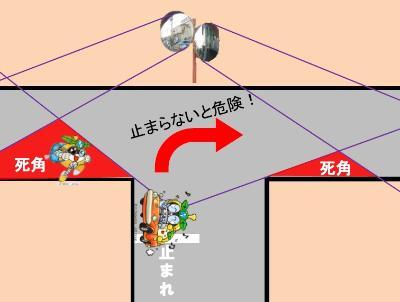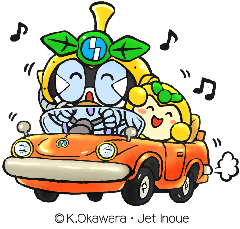Curve Mirror

Curve mirrors are traffic safety facilities installed at intersections, road bends, and sharp curves where visibility is poor, to allow drivers to check for other vehicles that are not visible to them. They are installed by the city and Tokyo Metropolitan Government.
The city is installing curve mirrors in places where visibility is poor for drivers on city roads to enhance traffic safety.
In addition, in the city, there are curve mirrors installed and managed by individuals to ensure visibility from private properties such as the entrances and exits of personal parking lots, in addition to those installed by the city.
Curve mirrors are very useful for recognizing the presence of approaching vehicles in advance, but they also have the following dangers.
Danger of Curved Mirrors
Danger 1: "Blind Spot"

There are "blind spots" that are not reflected in the mirror surface of the curve mirror.
Particularly, caution is necessary in areas where many children pass through.
Children are in the "blind spot" of the curve mirror because they are short.
Drivers should check the curve mirror to confirm that there are no approaching vehicles, but they should also assume that children or others may be hidden in the "blind spot". Therefore, it is necessary to proceed at a speed that allows for immediate stopping while slowing down, and to visually confirm safety directly with their own eyes.
Danger 2: "Unstoppable Car"

Generally, drivers should stop or slow down at intersections with poor visibility where no curve mirrors are installed, and proceed while visually confirming safety. However, when curve mirrors are installed, drivers can confirm that no approaching vehicles are present from a distance, which often leads them to enter the intersection without reducing speed.
In this case, if the speed of the vehicle is high and a contact accident occurs with pedestrians in the "blind spot," the severity of injuries will be serious.
In this case, the curve mirrors that are originally installed for safety are actually increasing traffic hazards, which is counterproductive.
Curve mirrors are merely auxiliary facilities for traffic safety, and the information obtained from curve mirrors should be considered as "reference" only. Ultimately, it is necessary for drivers to stop or slow down and confirm safety directly with their own eyes.
Summary of Risks

Recently, it has gradually been recognized that curve mirrors for traffic safety can sometimes induce traffic accidents.
Curve mirrors are merely auxiliary facilities for traffic safety.
To prevent a tragic accident, it is essential to visually confirm safety directly with your own eyes.
Just because there is a curve mirror, do not neglect to slow down or stop. Let's keep safe driving in mind.
When the city installs a curve mirror
The city takes the dangers of curve mirrors seriously and makes careful decisions when installing them.
There are the following conditions for the installation of curve mirrors.
Target Road
The applicable roads must meet both of the following criteria 1 and 2.
- A road with a width that does not obstruct vehicle passage even after installing a curve mirror.
- If any of the following apply
- City Road (including cases of entering and exiting Public Facilities)
- Roads (when intersecting with city roads)
- Private road that allows passage for an unspecified number of vehicles (when intersecting with a city road)
Consideration of Road Shape
Among the "targeted roads" mentioned above, we will consider the installation of curve mirrors if the sight distance cannot be secured due to the following road shapes.
- Curved sections and bent sections (parts of curves and L-shaped bends)
- In the absence of chamfering.
- If there is no sidewalk on the road on the intersection side.
If not installed due to environmental factors
Even if the above conditions are met, installations will not be made in places like the following.
- Roads with 'Stop' traffic regulations
Curved mirrors at intersections with a "Stop" traffic regulation can induce non-stopping and raise concerns about more serious accidents, so they will not be installed. - Roads near the elementary school commuting routes and Children's Center
In places where many small children pass by, shorter children may enter a "blind spot," which is dangerous, so in principle, we do not install them. - It will not be installed if it hinders the use of adjacent land or buildings.
[FAQ1] Even if I stop at the stop line for 'Stop', I can't see if any cars are coming. Could you please install a curve mirror?
Answer
If there is a traffic regulation of 'Stop', drivers must temporarily stop their vehicles just before the stop line.
Since the stop line is installed before the intersection, vehicles on the crossroad side are usually not visible from the stop location, and a curved mirror is not installed.
Drivers must slow down and proceed while visually confirming safety even after coming to a stop, and if there is a risk of obstructing the progress of vehicles passing through the intersecting road, they must take measures such as stopping again.
Furthermore, as mentioned in the above section on the "Dangers of Curve Mirrors," if a curve mirror is installed at an intersection with a "Stop" traffic regulation, it may encourage drivers to proceed without stopping or slowing down. This raises concerns about the potential for more serious accidents compared to situations without a curve mirror. Therefore, curve mirrors will not be installed in areas where a stop regulation is in place.
[FAQ2] Are there dangerous intersections where accidents actually occur? Can a curve mirror be installed?
Answer
A curve mirror will not be installed solely for the reason that an accident occurred.
By installing curve mirrors, it may encourage driving without stopping or slowing down, which can lead to more serious accidents compared to situations without curve mirrors. Therefore, we will carefully consider this in consultation with the Tama Chuo Police Station.
Please let us know your feedback on how to make our website better.
Inquiries about this page
Inagi City, Urban Development Department, Management Division
2111 Higashi-Naganuma, Inagi City, Tokyo 206-8601
Phone number: 042-378-2111 Fax number: 042-377-4781
Contact the Management Division, Department of Urban Development, Inagi City



















